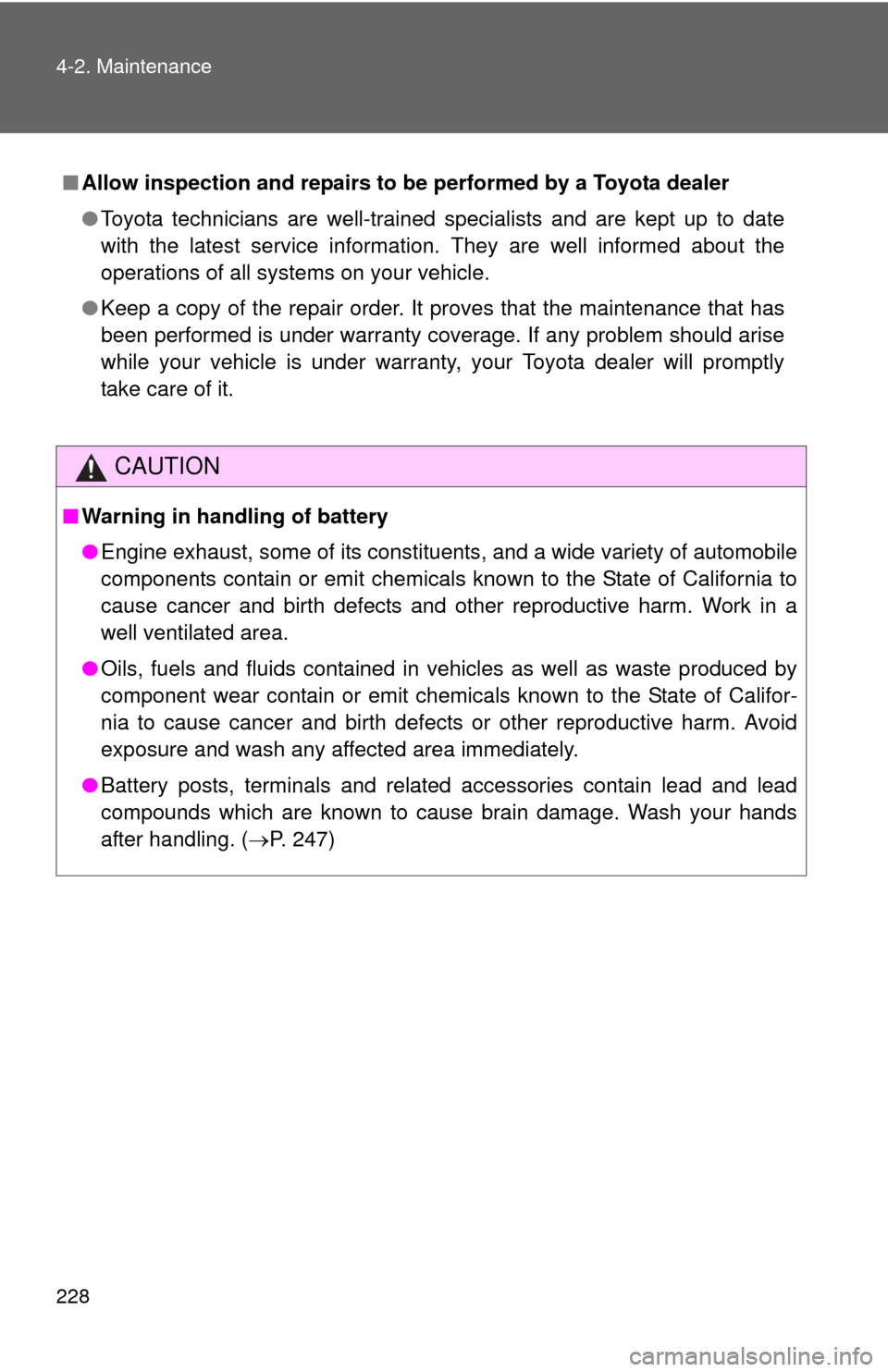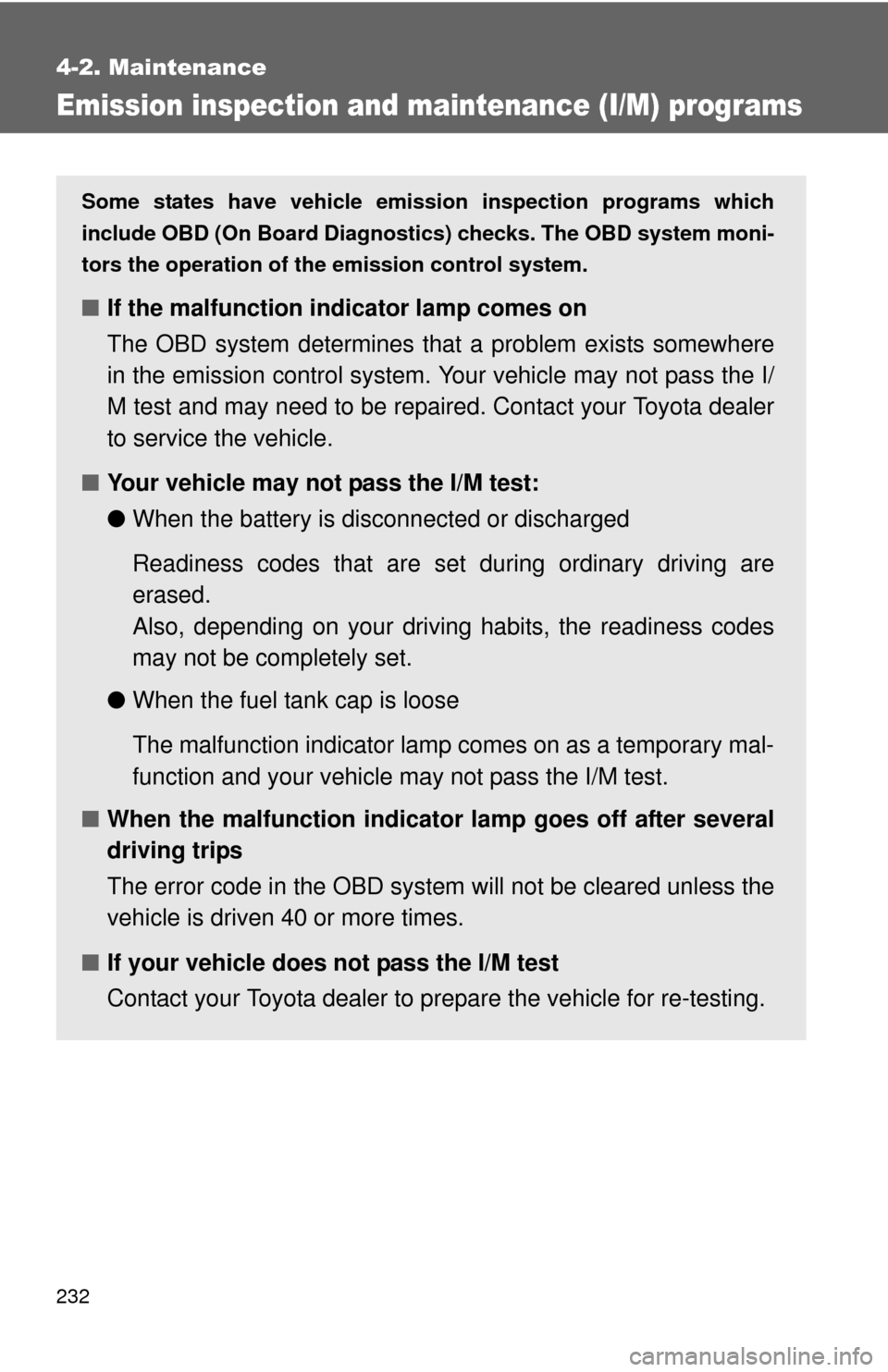Page 4 of 388

TABLE OF CONTENTSIndex
4
4-3. Do-it-yourself maintenance ................... 233
Do-it-yourself service precautions ...................... 233
Hood................................... 236
Positioning a floor jack ....... 237
Engine compartment .......... 239
Tires ................................... 252
Tire inflation pressure......... 258
Wheels ............................... 262
Air conditioning filter ........... 264
Key battery ......................... 267
Checking and replacing fuses ................................ 269
Light bulbs .......................... 280
5-1. Essential information....... 290 If your vehicle needs to be towed ............................... 290
If you think something is wrong ............................... 296
Fuel pump shut off system .............................. 297
Event data recorder............ 298
5-2. Steps to take in an emergency ...................... 300
If a warning light turns on or a warning buzzer
sounds... .......................... 300
If you have a flat tire ........... 310
If the engine will not start ... 323
If the shift lever cannot be shifted from P ................... 325
If you lose your keys .......... 326 If the vehicle battery is
discharged ........................ 327
If your vehicle overheats..... 332
If the vehicle becomes stuck ................................. 335
6-1. Specifications ................... 338 Maintenance data (fuel, oil level, etc.) ........... 338
Fuel information .................. 347
Tire information................... 350
6-2. Customization ................... 363 Customizable features ........ 363
Items to initialize ................. 365
Reporting safety defects for U.S. owners ...................... 368
Seat belt instructions for Canadian owners
(in French) ......................... 369
Abbreviation list ........................ 374
Alphabetical index .................... 375
What to do if... ........................... 383
5When trouble arises
6Vehicle specifications
7For owners
Index
Page 21 of 388
21
Scrapping your Toyota
The SRS airbag and seat belt pretensioner devices in your Toyota contain
explosive chemicals. If the vehicle is scrapped with the airbags and seat belt
pretensioners left as they are, this may cause an accident such as fire. Be
sure to have the systems of the SRS airbag and seat belt pretensioner
removed and disposed of by a qualified service shop or by your Toyota
dealer before you scrap your vehicle.
Perchlorate Material
Special handling may apply,
See www.dtsc.ca.gov/hazardouswaste/perchlorate.
Your vehicle has components that may contain perchlorate. These compo-
nents may include airbag, seat belt pretensioners, and wireless remote con-
trol batteries.
Page 151 of 388

151
2-5. Driving information
2
When driving
Winter driving tips
Carry out the necessary preparations and inspections before driving
the vehicle in winter. Always drive the vehicle in a manner appropri-
ate to the prevailing weather conditions.
■ Pre-winter preparations
●Use fluids that are appropriate to the prevailing outside tem-
peratures.
• Engine oil
• Engine coolant
• Washer fluid
● Have a service technician inspect the level and specific grav-
ity of battery electrolyte.
● Have the vehicle fitted with four snow tires or purchase a set
of tire chains for the front tires.
Ensure that all tires are the same size and brand, and that chains
match the size of the tires.
■Before driving the vehicle
Perform the following according to the driving conditions.
●Do not try to forcibly open a window, scrape an outside rear
view mirror surface or move a wiper or outside rear view mir-
ror that is frozen. Pour warm water over the frozen area to
melt the ice. Wipe away the water immediately to prevent it
from freezing.
● To ensure proper operation of th e climate control system fan,
remove any snow that has accumulated on the air inlet vents
in front of the windshield.
● Remove any ice that has accumu lated on the vehicle chassis.
● Periodically check for and remove any excess ice or snow
that may have accumulated in the wheel well or on the
brakes.
Page 165 of 388
165
2-5. Driving information
2
When driving
Dinghy towing (vehicles with a manual transmission)
Towing your vehicle with 4 wheels on the groundTo prevent damage to your vehicle, perform the following procedures
before towing.
Shift the shift lever to N.
Turn the engine switch to the ACC position.
Ensure that the audio system and other powered devices have been
turned off.
Release the parking brake.
After towing, leave the engine in idle for at least 3 minutes before
driving the vehicle.
■Necessary equipment and accessories
Specialized equipment and accessories are required for dinghy towing. Con-
tact the service branch of the motor home manufacturer regarding recom-
mended equipment.
Your vehicle can be dinghy towed in a forward direction (with 4
wheels on the ground) behind a motor home.
Dinghy towing does not elimi-
nate the possibility of damage
to your vehicle.
Page 221 of 388
Maintenance and care4
221
4-1. Maintenance and care ... 222Cleaning and protecting the vehicle exterior............... 222
Cleaning and protecting the vehicle interior................ 224
4-2. Maintenance ................... 227 Maintenance requirements .................. 227
General maintenance....... 229
Emission inspection and maintenance (I/M)
programs........................ 232 4-3. Do-it-yourself
maintenance ................. 233
Do-it-yourself service precautions .................... 233
Hood ................................ 236
Positioning a floor jack ..... 237
Engine compartment ........ 239
Tires ................................. 252
Tire inflation pressure ...... 258
Wheels ............................. 262
Air conditioning filter......... 264
Key battery ....................... 267
Checking and replacing fuses .............................. 269
Light bulbs........................ 280
Page 228 of 388

228 4-2. Maintenance
■Allow inspection and repairs to be performed by a Toyota dealer
●Toyota technicians are well-trained specialists and are kept up to date
with the latest service information. They are well informed about the
operations of all systems on your vehicle.
● Keep a copy of the repair order. It proves that the maintenance that has
been performed is under warranty coverage. If any problem should arise
while your vehicle is under warranty, your Toyota dealer will promptly
take care of it.
CAUTION
■Warning in handling of battery
●Engine exhaust, some of its constituents, and a wide variety of automobile
components contain or emit chemicals known to the State of California to
cause cancer and birth defects and other reproductive harm. Work in a
well ventilated area.
● Oils, fuels and fluids contained in vehicles as well as waste produced by
component wear contain or emit chemicals known to the State of Califor-
nia to cause cancer and birth defects or other reproductive harm. Avoid
exposure and wash any affected area immediately.
● Battery posts, terminals and related accessories contain lead and lead
compounds which are known to cause brain damage. Wash your hands
after handling. ( P. 247)
Page 229 of 388
229
4-2. Maintenance
4
Maintenance and care
General maintenance
Engine compartment
ItemsCheck points
Battery Maintenance-free. (P. 247)
Brake fluid At the correct level? (P. 246)
Engine coolant At the correct level? (P. 244)
Engine oil At the correct level? (P. 240)
Exhaust system No fumes or strange sounds?
Radiator/condenser/hoses Not blocked with foreign matter?
(
P. 246)
Washer fluid At the correct level? (P. 250)
Listed below are the general maintenance items that should be per-
formed at the intervals specified in the “Scheduled Maintenance
Guide” or “Owner’s Manual Supp lement”. It is recommended that
any problem you notice should be brought to the attention of your
Toyota dealer or qualified service shop for advice.
Page 232 of 388

232
4-2. Maintenance
Emission inspection and maintenance (I/M) programs
Some states have vehicle emission inspection programs which
include OBD (On Board Diagnostics) checks. The OBD system moni-
tors the operation of th e emission control system.
■If the malfunction indicator lamp comes on
The OBD system determines that a problem exists somewhere
in the emission control system. Your vehicle may not pass the I/
M test and may need to be repaired. Contact your Toyota dealer
to service the vehicle.
■ Your vehicle may not pass the I/M test:
●When the battery is disconnected or discharged
Readiness codes that are se t during ordinary driving are
erased.
Also, depending on your driving habits, the readiness codes
may not be completely set.
● When the fuel tank cap is loose
The malfunction indicator lamp comes on as a temporary mal-
function and your vehicle may not pass the I/M test.
■ When the malfunction indicator lamp goes off after several
driving trips
The error code in the OBD system will not be cleared unless the
vehicle is driven 40 or more times.
■ If your vehicle does not pass the I/M test
Contact your Toyota dealer to prepare the vehicle for re-testing.